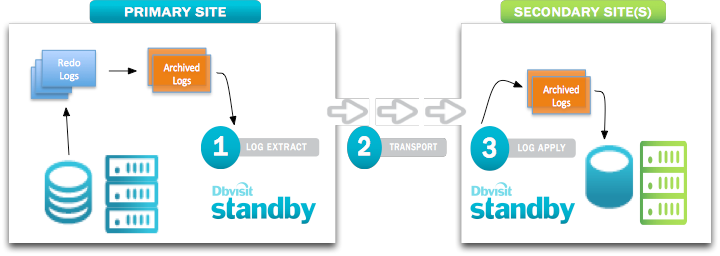Introduction
Dbvisit Standby automates the synchronisation of a hot standby database at a remote or local location. A standby database is like having an online hot backup of your database instantly available 24x7. There is no need to restore in the event of a disaster (which is very time consuming), as there is instant data and database recovery. It is possible to switch over to the standby database in a matter of minutes to allow business continuity in an emergency. No other software is required to replicate the primary database onto a separate standby server.
An overview of Dbvisit Standby architecture is presented in the figure below:
From the diagram above we can summarize the core functionality of Dbvisit Standby as a 3-step process:
Log Extraction
Dbvisit Standby will extract the primary database archive logs from the database archive destination. The following steps form part of the log extraction process:
The latest archive logs will be extracted to be shipped to the standby
A log switch will be performed if no new logs were generated since the last run
Logs will be compressed if the compression option is selected
If configured, Dbvisit Standby can also manage the archive logs on the primary server; example purge logs older than specified time
Transport
The second step in the process will be to copy these extracted archive logs to the standby site. This transfer process is initiated from the primary server and the transfer process is secure. The following steps form part of the log transfer process:
The latest archive logs will be transferred using the Dbvisit Network (Dbvnet) or SSH (Unix Only)
The connection between the primary and standby site is encrypted and secure
Archive logs will be transferred in compressed format if required
Checksum values are generated to ensure logs are transferred successfully
Log Apply
The third step in the process is where Dbvisit Standby applies the transferred archive logs to the standby database. The following steps form part of the log apply process:
On the Standby Server, Dbvisit Standby will pickup the transferred archive logs and apply them to the standby database
If configured, Dbvisit Standby can also manage the archive logs on the standby server; example purge logs older than specified time
